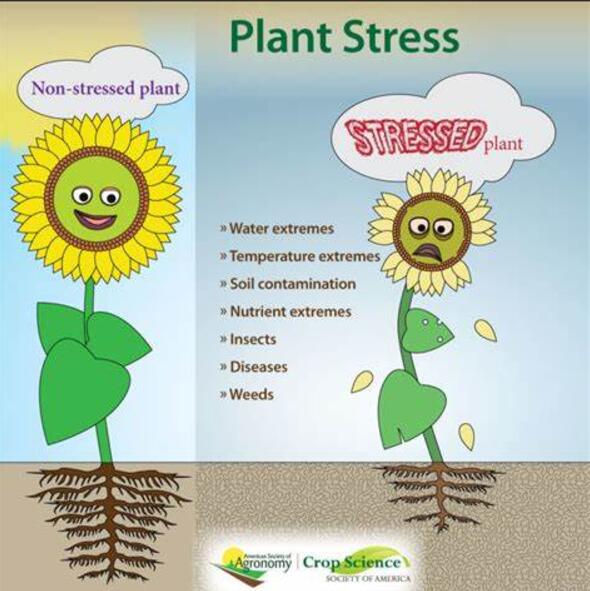蚕豆(Phaseolus vulgaris L.)抗炭疽病的生化防御武器库、基因/QTL 和转录本
IF 6.8
Q1 PLANT SCIENCES
引用次数: 0
摘要
由 Colletotrichum lindemuthianum 引起的炭疽病(ANT)是影响蚕豆(Phaseolus vulgaris L.)的最具破坏性的病害,导致喜马拉雅山西部的产量大幅下降。该研究通过性状表型、生化分析、全基因组关联研究(GWAS)和 RNA 测序,全面了解了 ANT 的抗性。对不同环境下的豆类关联图谱面板的评估揭示了不同的抗性水平。生化分析表明,不同基因型对 ANT 感染的防御反应各不相同。GWAS 方法确定了 24 个显著的标记-性状关联(MTAs),分布在所有 11 条豆类染色体上。值得注意的是,染色体 Pv07 上的 03 个 MTAs(BMr205、BMr269 和 BMr244)对 ANT 进行了验证,其余的 MTAs 是 ANT 的新型 MTAs。在模拟和接种后 120 小时条件下,对抗病基因型(PBG-3)和感病基因型(PBG-26)进行转录组测序,发现了一些关键的差异表达基因,如含亮氨酸富重复结构域蛋白(PHAVU_007G087700g)、含 NB-ARC 结构域蛋白(PHAVU_003G002500g)和对抗病至关重要的转录因子。四个基因(PHAVU_007G087700g、PHAVU_003G002500g、PHAVU_007G056100g 和 PHAVU_003G003000g)的表达模式通过定量反转录聚合酶链反应(qRT-PCR)得到了验证。此外,将 GWAS 确定的候选基因与转录组学相结合,并与之前的研究进行交叉比对,验证了重叠区域和共同候选基因,丰富了我们对 ANT 抗性遗传基础的认识。因此,研究结果提供了关于四季豆抗 ANT 的整体视角,为有针对性的育种工作奠定了基础。已确定的潜在候选基因和相关途径将为抗 ANT 蚕豆品种的开发提供宝贵的见解。本文章由计算机程序翻译,如有差异,请以英文原文为准。
Biochemical Defense Arsenal, Genes/QTLs and Transcripts for Imparting Anthracnose Resistance in Common bean (Phaseolus vulgaris L.)
Anthracnose (ANT), caused by Colletotrichum lindemuthianum, is the most devastating disease affecting common bean (Phaseolus vulgaris L.), leading to significant yield losses in the Western Himalayas. The study provides a comprehensive understanding of ANT resistance via trait phenotyping, biochemical profiling, genome-wide association studies (GWASs), and RNA sequencing. The assessment of bean association mapping panel in different environments revealed a diverse spectrum of resistance levels. Biochemical analysis revealed distinctive defense responses against ANT infection among different genotypes. GWAS approach identified 24 significant marker‒trait associations (MTAs) distributed across all 11 bean chromosomes. Notably, 03 MTAs (BMr205, BMr269 and BMr244) present on chromosome Pv07 were validated for ANT, and the remaining MTAs were novel MTAs for ANT. Transcriptome sequencing of resistant (PBG-3) and susceptible (PBG-26) genotypes under mock and 120-hour post inoculation conditions revealed key differentially expressed genes, such as leucine-rich repeat domain-containing protein (PHAVU_007G087700g), NB-ARC domain-containing protein (PHAVU_003G002500g) and transcription factors pivotal for disease resistance. The expression patterns of four genes (PHAVU_007G087700g, PHAVU_003G002500g, PHAVU_007G056100g and PHAVU_003G003000g) were validated through quantitative reverse transcription polymerase chain reaction (qRT‒PCR). Furthermore, the integration of GWAS-identified candidate genes with transcriptomics and cross-referencing with previous studies validated overlapping regions and common candidate genes, enriching our understanding of the genetic basis of ANT resistance. Therefore, the results offer a holistic perspective on ANT resistance in common bean, providing a foundation for targeted breeding efforts. The identified potential candidate genes and associated pathways will contribute valuable insights into the development of ANT resistant common bean varieties.
求助全文
通过发布文献求助,成功后即可免费获取论文全文。
去求助
来源期刊

Plant Stress
PLANT SCIENCES-
CiteScore
5.20
自引率
8.00%
发文量
76
审稿时长
63 days
期刊介绍:
The journal Plant Stress deals with plant (or other photoautotrophs, such as algae, cyanobacteria and lichens) responses to abiotic and biotic stress factors that can result in limited growth and productivity. Such responses can be analyzed and described at a physiological, biochemical and molecular level. Experimental approaches/technologies aiming to improve growth and productivity with a potential for downstream validation under stress conditions will also be considered. Both fundamental and applied research manuscripts are welcome, provided that clear mechanistic hypotheses are made and descriptive approaches are avoided. In addition, high-quality review articles will also be considered, provided they follow a critical approach and stimulate thought for future research avenues.
Plant Stress welcomes high-quality manuscripts related (but not limited) to interactions between plants and:
Lack of water (drought) and excess (flooding),
Salinity stress,
Elevated temperature and/or low temperature (chilling and freezing),
Hypoxia and/or anoxia,
Mineral nutrient excess and/or deficiency,
Heavy metals and/or metalloids,
Plant priming (chemical, biological, physiological, nanomaterial, biostimulant) approaches for improved stress protection,
Viral, phytoplasma, bacterial and fungal plant-pathogen interactions.
The journal welcomes basic and applied research articles, as well as review articles and short communications. All submitted manuscripts will be subject to a thorough peer-reviewing process.
 求助内容:
求助内容: 应助结果提醒方式:
应助结果提醒方式:


